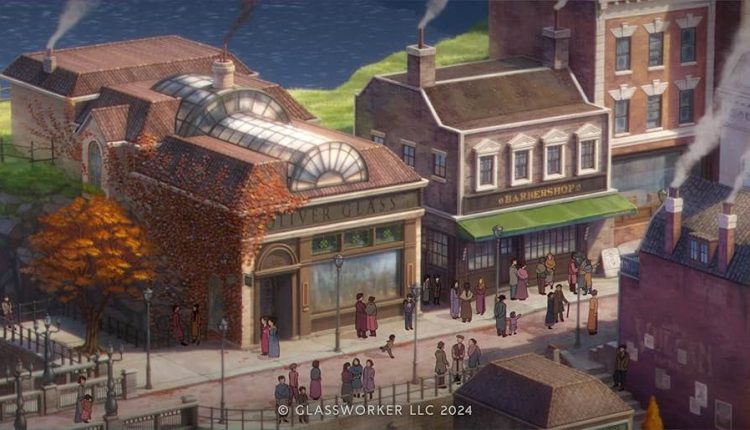The Glassworker — A Pakistani Animation with a Ghibli Heart
A Fusion of Pakistani Artistry and Ghibli Magic
In a world that’s growing at a breakneck pace, yet somehow also crumbling in unexpected ways, it’s getting harder for us humans to grasp our role. Are we defined by our boundless potential to create or by our staggering ability to destroy? These are the questions that “The Glassworker” — Pakistan’s first-ever hand-drawn animated feature film — poses to its audience. But this film doesn’t just leave us with questions; it firmly answers them in a way that sticks with you long after the credits roll.
“The Glassworker” isn’t just another animated film. It’s a monumental achievement for Pakistan, a country where animation has rarely been explored at this level. Directed by Usman Riaz, who is also the driving force behind Mano Animation Studios, the film is a love letter to the art forms that have inspired him, particularly the works of Studio Ghibli. But make no mistake, “The Glassworker” is not just an homage; it stands tall on its own, offering a unique narrative that’s both intimate and universal.
The film has been in the making since 2014, a labor of love that took nearly a decade to come to fruition. Usman Riaz, along with his team, including art director Mariam Pracha and producer Khizer Riaz, have crafted something that isn’t just a movie — it’s a piece of history. For Pakistan, it’s a pioneering effort in the world of animation, but for the global audience, it’s a must-watch for its artistry, storytelling, and emotional depth.
But let’s dive into what makes “The Glassworker” so special. Yes, it’s a visual treat, and yes, the soundtrack is nothing short of phenomenal. But there’s so much more to this film that warrants discussion, from its themes of love and war to its intricate character development. So grab your popcorn, or perhaps a bowl of gulab jamun (more on that later), and let’s explore the magical world of “”The Glassworker”.”
A Masterpiece of Animation and Music
When you think of animated films, especially those that draw inspiration from Studio Ghibli, the first thing that comes to mind is the quality of the animation. And “The Glassworker” does not disappoint. The hand-drawn animation is breathtaking, capturing the beauty of every scene with meticulous attention to detail. Whether it’s the vibrant colors of a bustling bazaar or the quiet, reflective moments between characters, the animation breathes life into every frame.
But what truly sets “The Glassworker” apart is how it uses animation to enhance its storytelling. The film doesn’t just rely on dialogue to convey emotions; it uses visual storytelling in a way that’s reminiscent of the best works of Ghibli. The characters’ expressions, the way they move, and the world they inhabit all contribute to the narrative in a way that’s both subtle and powerful.
And then there’s the music. Usman Riaz, who has a background in music, has composed a soundtrack that is nothing short of a masterpiece. The music is ethereal and intimate, perfectly capturing the mood of each scene and drawing the audience into the characters’ emotional journeys. It’s the kind of soundtrack that stays with you, long after you’ve left the theater.
But the music in “The Glassworker” isn’t just background noise; it’s an integral part of the story. One of the main characters, Alliz, is a skilled violinist who struggles to express her emotions except through her music. Her art becomes a way for her to communicate with the world around her, and the film’s soundtrack reflects this beautifully. The music allows us to connect with Alliz on a deeper level, understanding her in ways that words alone could never achieve.
The Whimsical and Raw World of “The Glassworker”
One of the most striking aspects of “The Glassworker” is how it creates a world that feels both whimsical and raw. The animation, with its vibrant colors and intricate details, draws you into a fantastical world that feels lived-in and real. This isn’t just a backdrop for the story; it’s a character in its own right, with its own history and emotions.
The film is set in a town that, while not explicitly stated, feels reminiscent of Pakistan. The bazaar scenes, in particular, are a joy to watch, filled with small details that make the world feel alive. Whether it’s the hustle and bustle of market stalls or the quiet moments of reflection in the glass workshop, the world of “The Glassworker” is one that you’ll want to revisit again and again.
And then there’s the food. Yes, food plays a significant role in the film, particularly the obsession with Gulab Jamun. These small, sweet treats appear throughout the film, adding a touch of whimsy to the story. But they’re more than just a nod to Pakistani culture; they serve as a symbol of the small joys in life, the moments of sweetness that make the struggles worthwhile. But while the world of “The Glassworker” is whimsical, it also has a raw, emotional depth that grounds the story in reality. The film doesn’t shy away from the harsh realities of life, particularly the impact of war. The characters’ struggles are real and relatable, making their triumphs all the more poignant.

Love War and the Art of Creation
At its heart, “The Glassworker” is a love story. But it’s not just about romantic love; it’s about love in all its forms. The film explores the love between a father and his child, the love between friends, and the love between an artist and their creation. These relationships are the emotional core of the film, driving the narrative forward and giving the story its depth.
But love in “The Glassworker” is complicated by the backdrop of war. The film is set in a time of conflict, and the impact of war is felt in every aspect of the characters’ lives. Vincent, the young glassworker, is learning his craft from his father, Tomas, while navigating the challenges of growing up in a town torn apart by war. His relationship with his pacifist father is strained by the pressures of their ultra-patriotic town, and his budding friendship with Alliz is complicated by her father’s role in the war.
The film doesn’t sugarcoat the impact of war; it shows how it corrupts and destroys, not just physically but emotionally and spiritually as well. But it also shows the power of creation, of art, as a way to resist and heal from that destruction. Vincent’s glasswork becomes a metaphor for his own journey, as he struggles to create something beautiful in a world that’s falling apart.
One of the most powerful moments in the film comes when Colonel Amano, Alliz’s father, visits Tomas and Vincent’s workshop. Despite being a man of war, he is drawn to a particular glass sculpture, created by Vincent. The sculpture is an abstract interpretation of a mother and her child, a symbol of the one thing the Colonel knows and values above all else. This moment, understated yet profound, captures the essence of “The Glassworker” — the connection between creation and the human experience.
The Subtle Power of Symbolism
Symbolism plays a crucial role in “”The Glassworker”,” adding layers of meaning to the story that enrich the viewing experience. The use of glass as a motif is particularly striking, symbolizing both fragility and strength. Glass, like the characters in the film, is delicate yet capable of being shaped into something beautiful. But it’s also easily broken, a reminder of the vulnerabilities we all carry.
The parallels between glasswork and music in the film are also noteworthy. Both Vincent and Alliz are artists in their own right, using their crafts to express emotions they can’t articulate in words. Their respective arts become a form of communication, not just with each other but with the world around them. The way these two art forms intertwine in the narrative is masterful, reflecting the characters’ growth and the impact of the world they live in.
But the symbolism in “The Glassworker” goes beyond just the obvious. There are subtle nods throughout the film that add depth to the story, rewarding those who pay attention. For example, the choice of colors in certain scenes, the placement of objects in the background, and even the way characters move all contribute to the narrative in ways that aren’t immediately apparent. This attention to detail is what elevates “The Glassworker” from a good film to a great one.
The Impact of “The Glassworker” on Pakistani Animation
“The Glassworker” is more than just a film; it’s a milestone for Pakistani animation. In a country where the animation industry is still in its infancy, the success of “The Glassworker” is a beacon of hope for aspiring animators and filmmakers. It proves that with passion, dedication, and a clear vision, it’s possible to create something that resonates on a global scale.
But the impact of “The Glassworker” goes beyond just the animation industry. It has the potential to inspire a new generation of artists, storytellers, and creators in Pakistan. The film’s success shows that Pakistani stories have a place on the world stage and that our unique perspectives and experiences are valuable and worth sharing.
For Mano Animation Studios, “The Glassworker” is just the beginning. Usman Riaz and his team have shown what they are capable of, and the world is eagerly waiting to see what they create next. The film’s success at the Annecy International Animation Film Festival and its upcoming release in Pakistan are just the first steps in what promises to be a bright future for the studio.

A Film Worth Watching and Rewatching
“The Glassworker” is a film that demands to be seen, not just once but multiple times. It’s a film that reveals more with each viewing, with layers of meaning and emotion that take time to fully appreciate. Whether you’re drawn to the stunning animation, the beautiful music, the rich symbolism, or the heartfelt story, there’s something in “The Glassworker” for everyone.
But beyond its technical and artistic achievements, “The Glassworker” is a film with a heart. It’s a story about love, war, and the power of creation, told in a way that’s both timeless and deeply relevant. It’s a film that stays with you, reminding you of the fragility of life and the beauty that can be found in even the most difficult circumstances.
So if you haven’t already, make sure to add “The Glassworker” to your watchlist. And when you do, prepare to be moved, inspired, and utterly captivated by this beautiful piece of Pakistani cinema.

